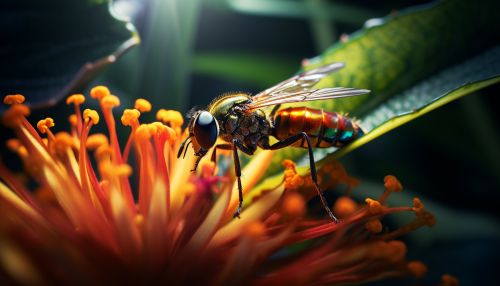The Science of Plant-Insect Interactions and Coevolution
Introduction
The science of plant-insect interactions and coevolution is a specialized field within ecology and evolutionary biology. It involves the study of the complex relationships and mutual influences between plants and insects, and how these interactions have shaped their evolutionary trajectories over millions of years.


Plant-Insect Interactions
Plants and insects have a myriad of interactions that range from mutually beneficial to antagonistic. These interactions can be broadly classified into two categories: mutualistic and antagonistic.
Mutualistic Interactions
Mutualistic interactions are those where both the plant and the insect derive benefits. The most common form of mutualistic interaction is pollination, where insects such as bees, butterflies, and beetles transfer pollen from the male anthers of a flower to the female stigma. This process aids in the plant's reproduction, while the insects receive nectar or pollen as a food source.
Another form of mutualistic interaction is myrmecophytes and ants. Myrmecophytes are plants that provide shelter and food sources for ants, which in return, protect the plant from herbivores and help in nutrient acquisition.
Antagonistic Interactions
Antagonistic interactions are those where one organism benefits at the expense of the other. In the context of plant-insect interactions, this usually involves insects feeding on plants. This can take various forms, such as herbivory, where insects feed on plant tissues, and parasitism, where insects lay their eggs inside plant tissues, and the emerging larvae feed on the plant.
Coevolution
Coevolution is the process where two or more species reciprocally affect each other's evolution. In the context of plant-insect interactions, coevolution has led to a variety of adaptations in both plants and insects.
Plant Adaptations
Plants have evolved a range of defenses against insect herbivory. These include physical defenses such as thorns and tough leaves, and chemical defenses such as the production of secondary metabolites that deter insects. Some plants have also evolved to mimic the appearance or smell of insects to attract pollinators.
Insect Adaptations
In response to plant defenses, insects have evolved a variety of counter-adaptations. These include the ability to detoxify plant toxins, the evolution of mouthparts that can overcome physical defenses, and the ability to locate and exploit plants that offer the best nutritional value.
Implications and Applications
The study of plant-insect interactions and coevolution has important implications for a range of fields, including agriculture, conservation biology, and pest management. Understanding these interactions can help in the development of sustainable agricultural practices, the conservation of biodiversity, and the control of pest species.
